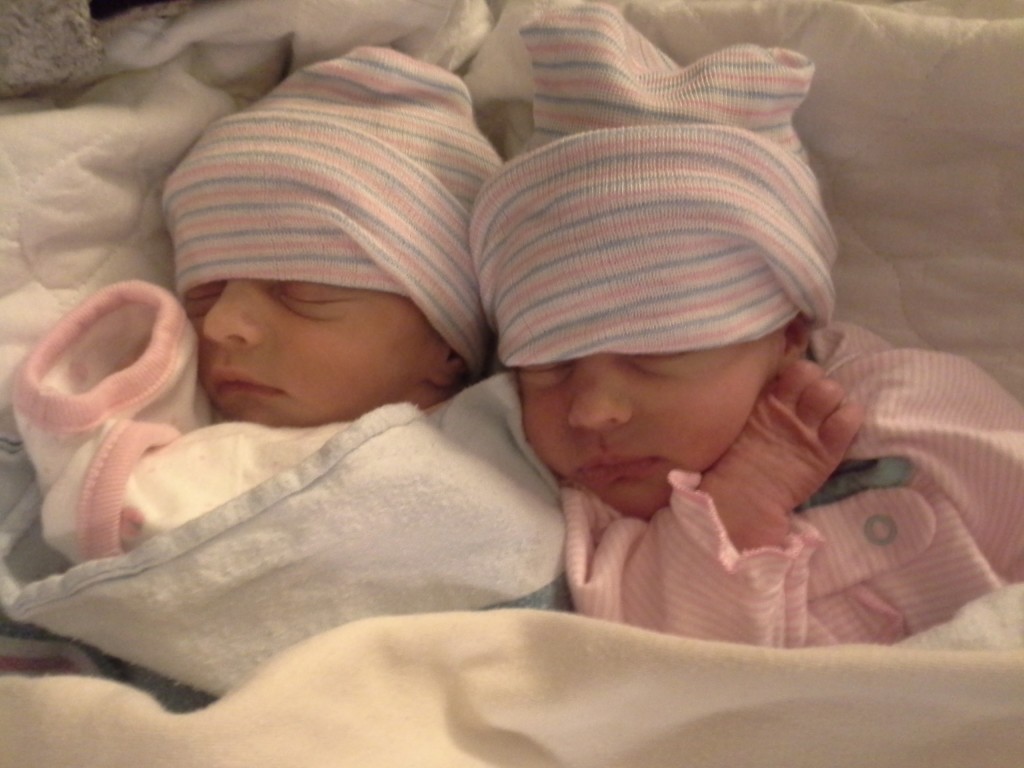
Awhile ago, I interviewed Elina Patler from Astoria, NYC about her vaginal twin breech birth. Here are the girls, Mari and Mila, at birth. Thanks so much for sharing your story!
Tell us a little about your pregnancy.
I got pregnant in June 2014, and was totally surprised when I found out I was expecting dichorionic diamniotic (DCDA) twins. DCDA twins have their own placentas and their own amniotic sacs–they only share the uterine space.
Did you always plan a vaginal birth?
I really wanted a vaginal birth, but I knew the statistics were not in my favor, and carrying multiples automatically made my pregnancy high-risk, which limited what I could even hope for. I hired a birth doula who had experience with multiples who I thought could advocate for me in the hospital. A home birth was out of the question, because generally, no one is willing to assist. And hospitals require twins to be delivered in the operating room rather than a regular labor and delivery room in case of emergency. What sometimes happens is that the mother will vaginally deliver the first baby (Baby A, the baby closest to the cervix) and then has to have an emergency C-section for Baby B. But despite these obstacles, I was hopeful that I could deliver vaginally.
What were you concerned about?
My primary concern was premature birth of my babies. An average twin gestation is 35 weeks, five weeks shorter than a normal 40-week singleton pregnancy. NICU time is not uncommon for twins, and I read as much as I could to prepare myself for any outcome. I was also concerned about a C-section. The rate of C-section with twins is very high, and getting higher.
How did the maternity care providers support you through your decisions?
I’m very lucky to live in New York City, where I have access to many excellent doctors. My doula recommended a maternal fetal medicine (MFM) practice in Manhattan specializing in high-risk pregnancies. About 15 percent of their patients are women pregnant with multiples, which is very high. They also support vaginal deliveries. I was assured that as long as there was no emergency and my Baby A was head down, Baby B could be any position and they would support me in a vaginal delivery. They also allowed me to have my doula in the OR with my husband and me.
Was breech position an issue at any point?
Yes. My Baby B was breech.
How did the birth go?
It didn’t go exactly as I planned, but overall it was great. My blood pressure started to creep up a little around 33 weeks, and by 35 weeks, the MFM doctors felt I should deliver the babies. We discussed it and decided to go for an induction at 35w2d. It went really well, and with my husband and my doula by my side, I labored for 19 hours in the labor and delivery room. I was even allowed to start pushing there, before being moved to the OR for the delivery. I delivered my Baby A—who had actually moved into the posterior (“sunny-side up”) position—just a few pushes and a few minutes after getting to the OR, and Baby B was born via breech extraction by my OB three minutes later. Because they were early, I couldn’t hold them right away, and Baby B ended up spending five days in the NICU for feeding and growing. But Baby A was in the room with me within about half an hour.
Can you tell me more about that? Why was baby B born by breech extraction?
My doctors told me that a breech extraction is the most successful for a vaginal delivery of the second baby. Using other techniques can result in an emergency C-section, which we obviously wanted to avoid. My OB was very skilled and experienced (she has delivered triplets vaginally!) and I had no complications or damage from the delivery. My recovery was fast and smooth.
What would you say to other women pregnant with twins?
Do your research and prepare for any outcome, and seek out doctors who specialize in high-risk pregnancies. Twin pregnancies are vastly different from singleton pregnancies. You need more calories, more rest, more visits with your OB/MFM team. Pre-term labor is a real concern, and complications like gestational diabetes and pre-eclampsia are much more common. Still, you can have a vaginal birth, even when one of the babies is breech.
Anything else you want to add about your experience?
The pregnancy and delivery seem easy now compared to the first few months of caring for and nursing two infants at the same time!
Read more about breech babies and how they are born.



